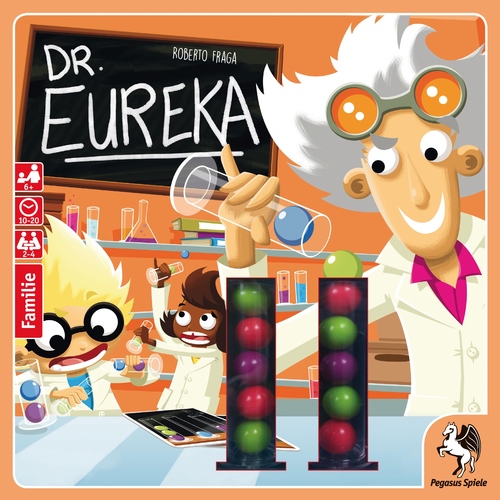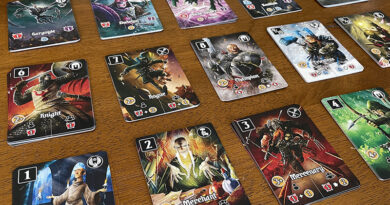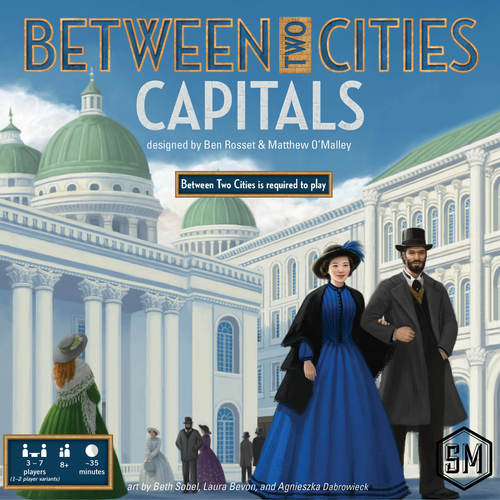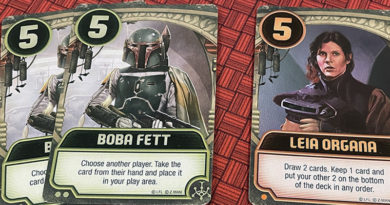A Dog’s Life family board game review
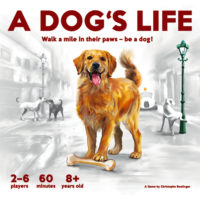
Have you ever wondered what life would be like as a dog?
As man’s best friend, maybe dogs have even wondered what life would be like as a person.
A number of movies have been made showing potential life through the eyes of pets, including one this year called A Dog’s Purpose where a dog finds the meaning of his own existence through the lives of the humans he teaches to laugh and love.
Well, now there’s a good option for seeing life through the eyes of a dog in the new family board game, A Dog’s Life!
A Dog’s Life let’s players take on the role of a dog when they step away from their master for a bit of fun. They’ll roam the neighborhood, beg in restaurants, deliver newspapers, search through trash cans, drink from fountains, piddle on lamp posts, and bury bones all while staying clear of the dog catcher.
Maybe it’s time your family sees what A Dog’s Life is all about.
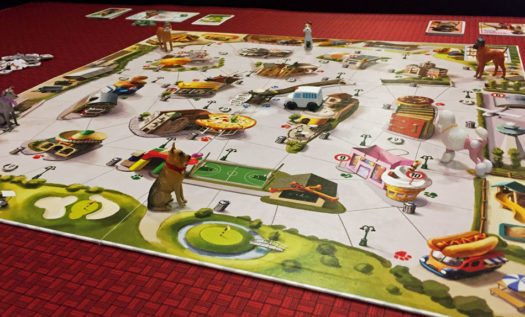
How to play A Dog’s Life
The goal in A Dog’s Life is to be the first dog to bury 3 bones in your den.
Players find and collect bones as they complete various actions during the game. Players also need to manage both their dog’s hunger level as well as their bladder!
To begin, each player chooses one of 6 dogs (Golden Retriever, German Shepherd, Poodle, Whippet, Boxer, Labrador, or Fox Terrier) and takes the corresponding dog board and set of Action cards. They shuffle their own deck of Action cards and place them in a draw pile face down. They then place their dog figure on their indicated starting den space.
On their dog board, players place their Hunger marker of their color on spot 4 (Full) and the Piddle marker of their color in one of the two bladder spaces.
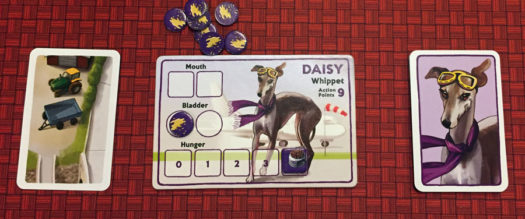
Player Turns
On a player’s turn, they complete 3 phases: Food, Dog Stuff, and The Dog Catcher
FOOD
This is a simple step where the player just moves their Hunger marker one space to the left. During the Dog Stuff step, players will be able to do things to feed their dog and move the marker back to the right.
If the marker is in the 0 space at the beginning of a player’s turn, the dog is starving and falls asleep from exhaustion. The player’s turn ends immediately and they place their dog in the first space of the dog shelter area. Anything their dog was carrying is left in the space the dog what in.
DOG STUFF
This is the main part of a player’s turn.
Each dog has a number of action points listed on their dog board. Every dog action and every space the dog moves to takes 1 action. As such, dog actions and movement can be taken in any order. Players also aren’t required to use all their action points on a turn (but points aren’t kept for subsequent turns).
When a dog takes an action (besides movement), they flip over their top Action card to see the result. Each Action card has 6 spaces that correspond to potential actions. The icon in the action space being performed indicates the result. For example, if searching the trash, the player would look at the icon in their card’s “Trashcan” space to see what they get.
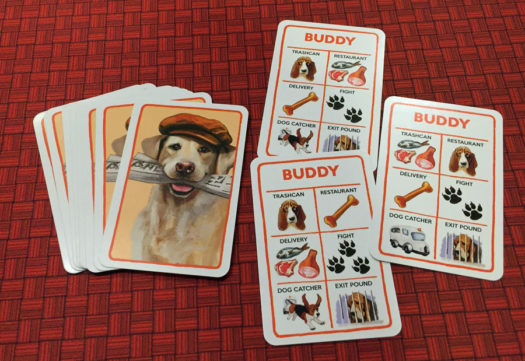
Here are the actions a dog can perform.
Movement: There are a handful of rules to a dog’s movement that we won’t go into detail on. Essentially, players use action points to move a dog to an adjacent street space in any direction they want. Three important rules are that figures can not occupy the same space, dogs can only enter buildings through the entrance space, and dogs can not pass through a square marked with another dog’s Piddle marker.
Search the Trash: If a dog is in a square with an un-searched trash can, the dog can search it for one action. The player flips their top Action card and gets the item shown. If it’s food, the player moves their Hunger marker to the right on their dog board that many spaces. If it’s a bone, the player takes a bone token and places in the Mouth space on their dog board. If it shows a sad dog, they found nothing.
The player then places a trash can marker on that space showing that trash can has been searched. If the last trash can marker is placed, it’s time for a Big Cleaning – where the streets are cleaned. All previous trash can markers and Piddle markers are removed from the board.
Begging at a Restaurant: When a dog is in a restaurant, the player can take an action to beg for food. The player draws their top card to reveal the result. A dog can not beg in the same restaurant more than once per turn.
Newspaper Delivery: When at the newsstand, a dog can take an action to get a newspaper. The player chooses one of the face down newspaper tokens, secretly looks at it, then places it face down in one of the Mouth spaces on their dog board. Each newspaper token has a unique number that corresponds to a certain building on the game board.
When a dog enters a building matching the number on their newspaper, the player takes an action to hand over the newspaper. The player then flips their top Action card to reveal their reward.
Having a Drink and Marking a Lamp Post: While in a space next to a fountain, the player can take one action to have a drink. When they do, the player places one of their colored Piddle markers in one of their bladder spaces on their dog board.
If a dog has at least 1 Piddle marker on their board and is in a space with a lamp post, they can place one of their Piddle markers from their board on the lamp post space.
If a dog lands on a space with another dog’s Piddle marker, that dog must stop to sniff – losing the rest of their actions for that turn.
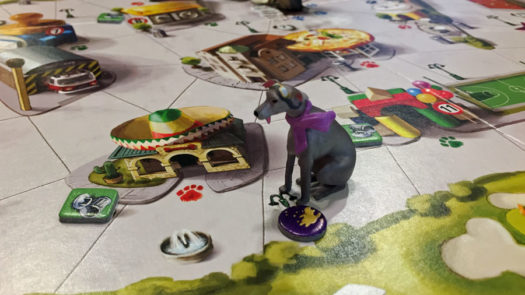
Dog Fight: If a player’s dog is in the street adjacent to another dog, they can start a dog fight for one action. Both the attacker and defender turn over their top Action card and compare results. The dog with the highest number of Paws wins the fight. The beaten dog drops everything in their Mouth onto their current space and moves one space in the opposite direction. If the number of paws are the same, the fight ends in a tie. The attacker may attack again if they still have actions and want to do so.
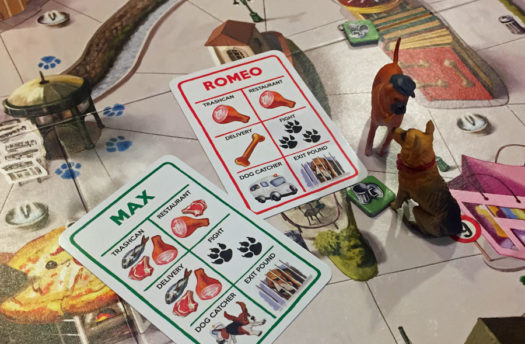
Picking up and Dropping Items: If a dog is in a square with a bone or newspaper token, they may pick it up and place it in their Mouth for an action. If a player wants to drop something from their Mouth to free up space for another item, dropping the item also costs an action.
Burying Bones: If a dog is in its Den space and has one or more bones in its Mouth, the player can use an action to bury a bone. (Each bone buried costs one action point.) The Bone token is placed on the Den card and remains there the rest of the game (can’t be stolen).
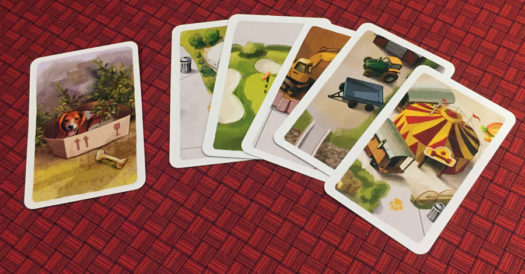
DOG CATCHER
The final phase of a player’s turn is the Dog Catcher phase.
The active player rolls the Dog Catcher red die and moves the Dog Catcher Car that number of spaces. The car can only move ahead, left, or right. It can not move backwards from the way it’s facing. When it comes to a stop, it remains facing the same direction.
The car can move through spaces with dogs and it always travels the exact amount as shown on the die.
If the car ends on a space with a dog, that dog is caught!
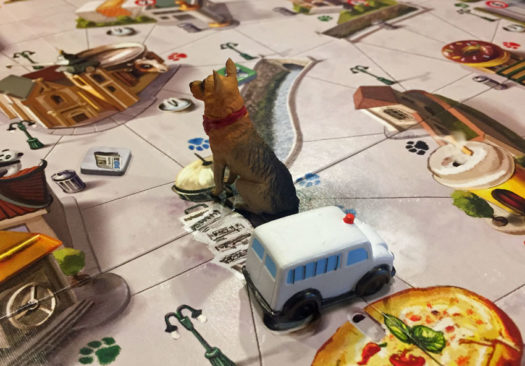
The dog drops everything from its Mouth into that space and the dog figure is moved to the first space of the Dog Shelter.
If the car stops adjacent to a space with a dog, that dog must turn over their top Action card and checks the Dog Catcher icon space on the card. If the icon is the car, the dog is caught. If the icon is a running dog, the dog gets away!
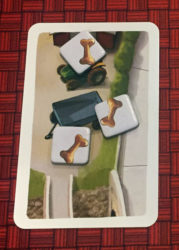
While in the Shelter, dog’s don’t get hungry. Instead, at the start of their next turn, they try to escape. The player flips their top Action card to see if they get free or remain in the Shelter. If the dog remains, they move their dog to the next space in the Shelter (closer to freedom).
After the Dog Catcher phase, a player’s turn is over and play proceeds to the player on their left.
End of Game
The game ends immediately when one dog buries a third bone in their den.
Can the whole family enjoy playing A Dog’s Life?
It’s easy to see that A Dog’s Life board game was made specifically for families. It’s a board game with a super friendly theme and simple game play mechanics.
While the centerpiece of the game is a board with a spaces for movement, it’s not your standard roll-and-move game. Players are free to travel in any direction they want on the board!
If they want to go beg at restaurants, they’re free to do so. If they want to pick fights with others dogs, they can do that too.
The only rolling of a die is for the neutral Dog Catcher – which every player gets to control on their turn.
That being said, there’s still a big amount of luck involved in the game.
Instead of rolling dice, players turn over their Action cards to see the result of their actions. And while it’s not dice, it’s still luck-driven.
Players may do great at using their movement to get to trash cans, restaurants, or even delivering newspapers to end up with nothing when they flip their card.
The player that wins will be the player that gets lucky with their cards.
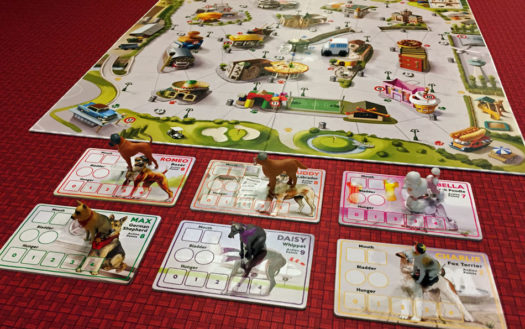
But we’re okay with luck in a family board game. It means that kids have a great chance at beating their parents.
The game doesn’t pretend to be a deep strategy game. So having a luck-of-the-draw element shouldn’t come as a surprise.
Also, each type of dog has it’s own unique strengths. Rather than having different special abilities, each dog has different probabilities within their deck of Action cards.
It’s good for players to know the strength of their dog before beginning play. So if they have a dog that’s more likely to get a bone at restaurants, then they’ll want to beg more often.
The back of the rule book has a section on each dog that also shares their strengths. For example, Romeo the Boxer is the strongest dog in town and likes to search the trash and take bones from other dogs (fight).
A Dog’s Life is also more fun with more players!
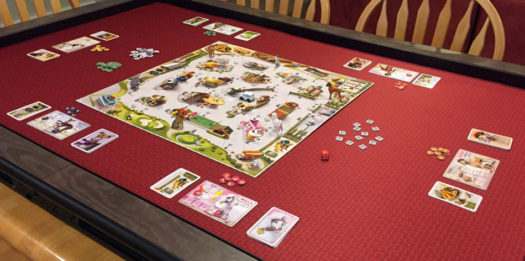
The box shows the player count as 2-6 players. But we wouldn’t recommend playing it with just 2 or 3 players. That’s because it’s a big town.
With less than 4 dogs running around, players won’t have as much interaction with each other. That doesn’t just mean less dog fights. But it also means the Dog Catcher has way to much empty space to roam. No one gets caught in a 2-player game. It also means that piddling on lamp post to block other player movement is totally unnecessary – because with only 1 or 2 opponents, they just won’t pass your dog’s way.
I guess it just means that dogs have more fun when there are lots of other dogs around.
How does A Dog’s Life score on our “Let’s Play Again” game meter?
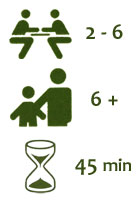 In our family, A Dog’s Life gets a mixed result on our “let’s play again” game meter. The main reason is because of the age of our kids. Now all our kids are teenagers and above, they prefer games with more decisions and more interaction.
In our family, A Dog’s Life gets a mixed result on our “let’s play again” game meter. The main reason is because of the age of our kids. Now all our kids are teenagers and above, they prefer games with more decisions and more interaction.
But for families with young kids, we can totally see A Dog’s Life getting many repeat plays. The dog figures are super cute and well made and the game play is engaging for young players.
If your kids are just getting into playing family board games, we’d recommend you give A Dog’s Life a play.
We’d like to thank Beton Games for a review copy of A Dog’s Life.

